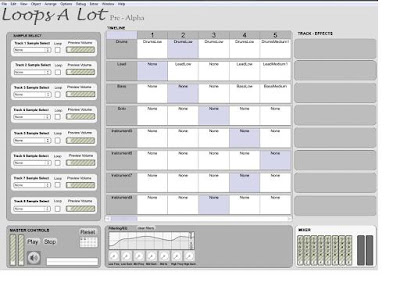The timeline is the area where you construct your track. In loops a lot constructing a track simply means you are lining up a set of musical loops from different instruments. To start constructing your track, simply follow the instructions set out below.
The Timeline Window:
The timeline consists of 8 separate horizontal tracks, one for each instrument. Each of these tracks can hold 39 different musical loops in any order.

The timeline section is the table in the centre of the program, for the time being only the top 4 tracks are in use.
Adding Loops in Sequence:
Each column is numbered at the top of the window, to allow you to match up sounds. the sections can all be individually selected, to allow you to add a loop.

To add a loop to a certain track and column, all you have to do is select the space on the track that you want to add an instrument to. Click on the drop down box to the left of the timeline window, underneath the track sample select section. This drop down is a list of all the samples that are available for the specific track.

Selecting a track from this box, also acts as a preview function. The volume of this preview is next to the sample select. This allows you to listen to several different loops and decide which one you would like to use.
Playing a Track:
To play the track you can select the play button in the bottom left hand corner in the ‘MASTER CONTROLS’ section. This will play from the first column and will play every track. You can also use the SPACE BAR to start and stop the track from the beginning.
To play the track from a select point, choose the column number at the top, this will highlight all the corresponding tracks in the correct place. If you press the ‘S’ key, the timeline will play from here.
Mixing:
The mixer is situated in the bottom right hand corner of the program, this allows you to choose the individual volumes of each of your instruments, allowing you to control how the instrument stands out in the overall song.


